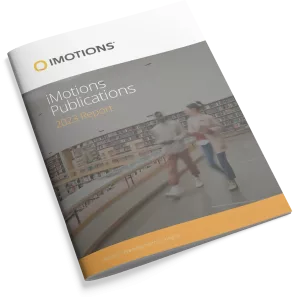-
Validating Physiological Stress Detection Model Using Cortisol as Stress Bio Marker
Abstract: In this work, we have presented the validation of a stress detection model using cortisol as the stress biomarker. The proposed model uses two physiological signals: Galvanic Skin Response (GSR) and Photoplethysmograph (PPG) to classify stress into two levels. GSR and PPG signals were collected from a total of 13 participants along with saliva […]
-
The Use of Eye Tracking Technology in Aesthetic Surgery: Analyzing Changes in Facial Attention Following Surgery
The ability to quantitatively analyze how we look at a face and determine if this changes following facial surgery should be of interest to the plastic surgeon. Eye tracking technology (ETT) provides the ability to record where observers fixate when viewing a facial image, enabling quantitative data to be obtained comparing pre- and postoperative changes. […]
-
Eye-Tracking the City: Matching the Design of Streetscapes in High-Rise Environments with Users’ Visual Experiences
Abstract Large cities in the West respond to an ever-increasing shortage of affordable housing by accelerating the process of urban densification. Amsterdam, for instance, aims to increase its housing stock by 10 percent in the next 15 years as its population is expected to grow by 20 percent. As in other cities, it seems inevitable […]
-
PRIME: Block-Wise Missingness Handling for Multi-modalities in Intelligent Tutoring Systems
Abstract: Block-wise missingness in multimodal data poses a challenging barrier for the analysis over it, which is quite common in practical scenarios such as the multimedia intelligent tutoring systems (ITSs). In this work, we collected data from 194 undergraduates via a biology ITS which involves three modalities: student-system logfiles, facial expressions, and eye tracking. However, […]
-
EyeCar: Modeling the Visual Attention Allocation of Drivers in Semi-Autonomous Vehicles
Abstract: A safe transition between autonomous and manual control requires sustained visual attention of the driver for the perception and assessment of hazards in dynamic driving environments. Thus, drivers must retain a certain level of situation awareness to safely takeover. Understanding the visual attention allocation of drivers can pave the way to inferring their dynamic […]
-
Sadder but wiser: Emotional reactions and wisdom in a simulated suicide intervention
Abstract: Scholars within the Berlin paradigm have analysed participants’ responses to a hypothetical vignette about a friend’s suicide ideation. However, no study has yet focused on participants’ emotional reactions to this scenario, an important aspect of wisdom performance. We conducted a Thin‐Slice Wisdom study where participants were asked to give advice to a hypothetical friend contemplating […]
-
Factorized Multimodal Transformer For Multimodal Sequential Learning
Abstract: The complex world around us is inherently multimodal and sequential (continuous). Information is scattered across different modalities and requires multiple continuous sensors to be captured. As machine learning leaps towards better generalization to real world, multimodal sequential learning becomes a fundamental research area. Arguably, modeling arbitrarily distributed spatio-temporal dynamics within and across modalities is […]
-
Brand Visual Eclipse (BVE): When the Brand Fixation Spent is Minimal in Relation to the Celebrity
Abstract: This study investigates overshadowing effect of a celebrity. A term brand visual eclipse (BVE) is coined, the BVE occurs when brand fixation spent is minimal of the celebrity fixation spent. High BVE occurs when brand receive less than or equal to twenty percent fixation spent of the celebrity; moderate BVE occurs when the brand […]
-
The effect of food anticipation on cognitive function: An eye tracking study
Abstract: By randomizing the order in which participants perform a cognitive test and a food choice task in a controlled experiment, we investigate whether cognitive capacity can be enhanced by the simple act of anticipating food intake. Our findings show that overweight and obese participants exhibit an anticipatory food reward effect, which helped enhance their […]
-
The Cognitive Dimension and the Affective Dimension in the Patient’s Experience
This article deals with the experience of the specific client of health services, that is, the patient. Satisfaction questionnaires are usually applied to assess patient experience. However, this tool provides only a cognitive evaluation; it does not afford an affective dimension of the experience. The objective of the present study is to verify the relationship […]
Research Report 2023
In-depth look at the scientific landscape as powered by iMotions software, showcasing groundbreaking research and the impact of our tools in various scientific and industrial fields.

Share Your Research

850+ universities worldwide with an iMotions human behavior lab
73 of the top 100 highest ranked universities
710+ published research papers using iMotions
iMotions is used for some of the most interesting human behavior research studies carried out by top researchers around the world. Contact us to have your publication featured here.
The authors of these publications have used iMotions as a software tool within their research.
“Software should be cited on the same basis as any other research product such as a paper or a book; that is, authors should cite the appropriate set of software products just as they cite the appropriate set of papers” (Katz et al., 2020).
We therefore encourage you to cite the use of iMotions where appropriate.
How to cite iMotions
APA
iMotions (10), iMotions A/S, Copenhagen, Denmark, (2024).
Note: adjust the version and year where relevant.
5 Most Popular Blogs
Learn How to Conduct Human Behavior Research with iMotions
Publications
Read publications made possible with iMotions
Blog
Get inspired and learn more from our expert content writers
Newsletter
A monthly close up of latest product and research news





